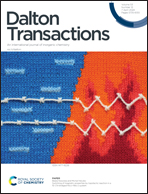Mitochondria-targeted ruthenium(ii) complexes for photodynamic therapy and GSH detection in living cells†
Abstract
Photodynamic therapy is an emerging tumor therapy that kills tumor cells by activating reactive oxygen species (ROS) produced by photosensitizers. Mitochondria, as an important organelle, are the main generator of cellular ROS. Therefore, the development of photosensitizers capable of targeting mitochondria could significantly enhance the efficacy of photodynamic therapy. In this study, two novel ruthenium(II) complexes, Ru-1 and Ru-2, were designed and synthesized, both of which were functionalized with α,β-unsaturated ketones for sensing of glutathione (GSH). The crystal structures of the two complexes were determined and they exhibited good recognition of GSH by off–on luminescence signals. The complex Ru-2 containing aromatic naphthalene can enter the cells and react with GSH to generate a strong luminescence signal that can be used to monitor intracellular GSH levels through imaging. Ru-2 also has an excellent mitochondrial localization ability with a Pearson's coefficient of 0.95, which demonstrates that it can efficiently target the mitochondria of tumor cells to enhance the effectiveness of photodynamic therapy as a photosensitizer.



 Please wait while we load your content...
Please wait while we load your content...